Every meta has decks you will love and hate. For many, these feelings will arise on the basis of something as simple as power level: the broken decks are the ones most treasured or despised, depending on whether you enjoy playing it. However, there are reasons to feel positively or negatively about decks or cards for reasons that have little to do with their average power levels. Sometimes there are things more fundamental to the way they are designed that can give rise to these emotions, even if they are underperforming.
That’s not to say that power levels don’t matter, just that you don’t need to tether every feeling you have about things to whether or not they’re Tier-1-levels of broken. With that said, let’s dive into some of the highs and lows I have seen rise from the Uldum meta.
Why Not Both?
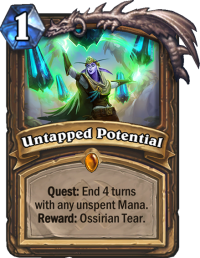
Kicking things off, the Druid Quest Untapped Potential feels awful from a design perspective because it doesn’t feel like a quest at all. It doesn’t require that decks be built in any particular way to the point that even non-Druid decks could complete the Quest as easily as Druids (even if the reward isn’t as useful). It doesn’t even require that the Druids do anything to complete it, as you complete by not doing things. Putting it bluntly, this “quest” – if we’re even going to call it that – can be completed by an AFK player with any class. Further, when the quest is completed, the reward is completely passive, requiring no input of mana from the Druid, unlike every other quest reward in the set.
So it’s not a quest as much as timer, and when that timer goes off almost every card in the Druid’s arsenal becomes insanely powerful. The sheer consistency that comes with the quest feels silly when I consider how I’ve played Quest Rogue lists with half the deck devoted to completing the Quest and often only finish doing so after my Druid opponents.
This is topped off with the fact that it removes everything about the “Choose One” cards that is interesting: the part where you, well, choose one effect. Choosing one provides flexibility at the cost of options that might not be optimal. Being able to choose both, always, at zero extra cost, just leaves you with cards that are more powerful than they should be.
This isn’t to say the deck is unbeatable or overbearing on the meta, but rather to simply say the design is horrible. It requires zero player input to build a deck that could complete it, to actually complete it in a match, or to use it after completion, all while making previously-interesting choices about card usage irrelevant.
Death Will Rise From The Tide
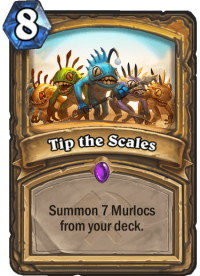
Another low-point, design-wise has been the Murloc Paladin deck. This deck leverages the interaction between Prismatic Lens, Tip the Scales, and having no other spells in the deck. The typical outcome of having Prismatic Lens before turns 3 or 4 (depending on if you’re on the coin) then, is a card that reads “Draw and Play 7 minions from your deck (with synergy that may also draw other cards when they die)” for approximately 1-3 mana. While some decks are capable of dealing with that, a lot of the time it will just result in a win on the spot, akin to what Barnes used to be for Big Priest, but you get to play two copies of it. For perspective, the average win rate of the deck when it has a Lens in the mulligan is approximately 67%.
The absurd nature of that interaction get even weirder when you fully account for the impact this had on deck building in Paladin. If you remember from the Divine Favor Hall-of-Faming announcement, the Hearthstone team indicated that they didn’t want card draw to be one of the Paladin’s strengths. It would be odd, then, for an aggressive Paladin deck to play cards like Zephrys the Great (with many duplicates in their list) and Chef Nomi because the player can be relatively assured it will cycle through most or all of their deck if it draws Prismatic Lens, yet here we are.
Again, while this deck is not unbeatable, this type of play pattern is fundamentally bad for the game experience. When a player doesn’t have an answer to “my opponent drew lens,” by turn 4 they might as well just find the concede button. It’s very similar to why players had been clamoring for a nerf to Barnes for several years before finally getting it.
Bright Parts of the Uldum
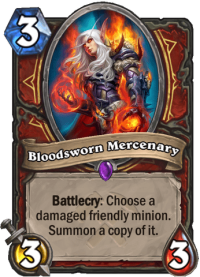
Things aren’t all doom and gloom from a design perspective, though. A bright beacon of solid design in Uldum has been how the Aggro/Tempo Warrior lists have been shaping up. These decks represent some of the best fundamentals that Hearthstone has to offer: fighting for board in the early game, making pushes for the face in the later stages, and all throughout the experience is one that doesn’t feel like something unusually unfair is happening. While the deck does offer some potential for massive blow-outs in the early game when it draws the precise unanswered threats and combo pieces, this is generally not how the deck operates.
It manages to maintain a healthy win rate without causing people the same grief that aggressive decks of the past (like Pirate Warrior) tended to and without packing unhealthy amounts of non-interactive burst tools.
Ever since the reversion of the Extra Arms buff, the Combo Priest decks have also been posting good results and doing powerful things without breaking the foundations of the game play experience. While I understand that to some decks like Warrior and Priest might feel a little boring or linear, they represent the core of what makes Hearthstone a great game. They are decks which contain 30 cards placed in that deck intentionally, creating consistent game plans that both players are capable of planning for. While this isn’t to deny that “Created By” cards can generate exciting moments throughout the game, there’s something to be said for how much fun those moments are in relation to their rarity. When those moments happen all the time, they might cease to be fun and interesting and instead become tedious and frustrating.
Created By Meta
And make no mistake: these “Created By” cards are becoming an increasingly-large share of designed and shipped sets, sometimes reaching peaks close to every third card in a set by my estimates. Whether they create a single extra resource that shouldn’t be able to be included in a deck or many, they are rapidly becoming the normal state of affairs.
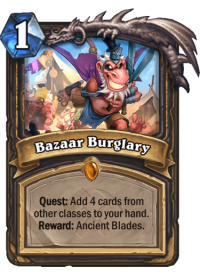
As a great case-in-point, one final aspect of the meta that I’m a bit ambivalent about is Quest Rogue. As a lifetime member and president of Valeera’s fan club, I do love Bazaar Burglary. Playing with the powerful tempo tools provided by the Quest and burgle synergies is a lot of fun and all the cards in the deck that create other cards from outside the game ensure that games are seldom the same. Figuring out what resources I will get and how to use them can be exciting and the deck is a blast for me to play.
Yet I can’t help but wonder whether my opponents have as much fun against the deck as I have piloting it. From their perspective, they don’t know what cards I’m generating and so their ability to plan and play around things is, in many respects, minimized. When they get slammed by a board clear I shouldn’t have access to in my deck, do they feel like they had fun or that they got cheated? If I burgle nothing useful do they feel their win was well deserved and satisfying? Is this the type of experience that should be fostered in Hearthstone and, if so, to what extent? Again, if the rules get broken all the time then those breaks cease to be novel and may instead erode something very core about what makes Hearthstone the game it is. Just ask anyone who has been through a Control Warrior mirror match and had it determined by who drew Dr. Boom, Mad Genius first or who got the better Archivist Elysiana.
This is why I highlighted the tempo-based Warrior and Priest decks as excellent parts of the meta. They represent some essential components of what makes Hearthstone great and help plant our feet to the ground so we can better appreciate those times things get shaken up.
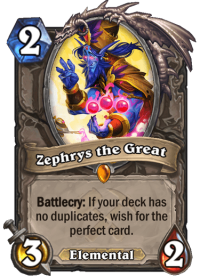
In a similar vein, I know Zephyrs has been a polarizing card as well with respect to enjoyment. Some people love Highlander decks because they think they are hard to build, bring diversity to the meta, and make games feel different. Others hate these same decks, retorting that they aren’t any harder to refine than decks with duplicates, don’t usually make too many new and exciting cards see meta play, and can largely reduce matches to the question of, “Did my opponent draw their large power spike that I couldn’t realistically play around?” instead of whether a deck executed its overall strategy.
For my money, I fall into the latter group. Getting beaten by my opponent drawing their power spike card has felt bad from Prince Keleseth to the original Reno Jackson. The experience of losing to one of those cards gets old almost immediately. I was not pleased to see the Highlander mechanic return, much less seeing it played even in decks that contain plenty of duplicates because they intend to cycle their deck as quickly as possible (which we saw previously in Murloc Paladin). In that respect, if Highlander cards must exist, I would prefer their design at least speak to the original content of a deck. That is, their effect could begin: “If you deck began with no duplicates…” before giving the payoff. While I’d rather they not exist at all, if they must I’d like least like a design that specifically encourages one type of deck so as to reduce their ubiquity.

Enjoyed reading your on-point thoughts alot!
Personally I don’t mind Highlander decks existing the way they are, but I agree on the other parts mentioned in your article!
I want to give some personal thoughts on certain things I like/dislike as well:
Being able to basically find good decks for every class and each of them having multiple archetypes available, currently makes the game a lot of fun when it comes to deckbuilding!
There is three major issues though, I really dislike how they are handled and introduced by Blizzard at the moment:
-Class Identities
-Herocards
-Broken Stuff (Imbalance)
I want to give a short (I really tried!) and quick inside, what I mean by each of them:
I think class identies are basically not existent at the moment. This might be due to the “created by meta” mentioned in the article. Every class having access to healing, armor, weapons, burst, card draw etc. feels weird, especially when these things should belong to certain classes only, and not occur for everybody on a frequent rate. Its not the discover mechanics only though, as mentioned in the article, Paladin for example has a lot of card draw available right now and this is really confusing when you were following the reasoning behind recent changes (HoFing “Divine Favor” to deny Paladin card draw in this case). So in my view basic and classic set should be updated to give every class a clear identity and the other sets should be adapted to that. Before even fixing the existing class identities though, Blizzard decided to introduce new identities in form of “lackeys” and “twinspells”. Don’t get me wrong, I really love the idea behind it! It’s the theme of a certain expansion and in the case of RoS it gives 4 classes the “defender” identity, using “twinspells” and 5 classes the “attacker” identity, using “lackeys”. Well now I go to my collection and type those keywords in the search bar. In case of the twinspells its fine, I find 4 classes, 2 twinspells each, great. In case of the lackeys though, i find 1 card for priest, 2 for rogue, 3 for shaman, 4 for warlock, 2 for warrior and 1 NEUTRAL! Wait what? You might say now in RoS there was only 1 lackeycard for each mentioned class except Rogue (Toggwaggle was a second rogue card introduced that needs a lackey to be active) and yes you are right, but in SoU there is kind of a lackey imbalance between the classes now. Since all lackeys have battlecries and Shaman just got a quest working around battlecries, its not confusing shaman has found a way to abuse this. It really doesn’t look thought-through well enough. So the idea behind lackeys and twinspells, giving an expansion a certain theme and certain classes new identities/tools to work with is a great thing, but in case of lackeys I really dislike the way it is implemented in the game right now.
Same story with Herocards!
I play Rogue vs Hunter. It is an even battle for board with weapons, spells and Minions trading. We are both down to 1 card and 10 mana it is really a close good game. Zuljin comes down, game is over, fun experience! No it’s not! I literally hate when that happens. Why? Well because as Rogue I don’t have access to a “Zuljin” card.. To get this right, I like cards like Zuljin doing powerful stuff on 10 mana, but I hate when there is an imbalance between classes and not every class has access to such tools. It just feels unfair and I want every class to have powerful tools available fitting their class identity! In case of herocards like boom, hagatha, zuljin, just give them to every class and don’t overtune them like some KotFT cards (e.g. Jaina giving Mage access to endless heal and once again ignoring class identities!). I mean Dr. Boom basically shows again how an overtuned Herocards looks like even after the nerf.
Which leads directly to my last point, Broken Stuff (Imbalance). I totally like broken stuff happening, but I want it to be difficult to execute and not rewarding without any sacrifice. More importantly though, it should be somewhat balanced between classes (for example not every class has a hero card available as mentioned before). Other examples would be Jaraxxus who can be destroyed by a 0 mana spell, while all other Heroes can’t be destroyed at all? Especially with a card like Zephrys introduced, its even worse and the Warlock Hero basically can’t be played currently, due to that interaction. Furthermore we have weapon destruction which makes some Weapon based strategies unplayable, again especially with a card like Zephrys around. I think everybody knows some examples here and again, I am fine with powerful stuff happening, but it should be a bit more balanced between classes especially how many (usable) tools are available to each class!
“Why? Well because as Rogue I don’t have access to a “Zul’Jin” card”
I think you do actually… its called “Tess Graymane”. Its not a hero card, but her effect its pretty similar to Zul’Jin. In some regards, Tess is even more OP, since she is a minion, you can copy and replay her many times, while you can only play Zul’Jin once.. Its less consistent but she can be quite powerful.
I know that she does not fit into every rogue deck, but Zul’Jin doesn’t fit into every hunter deck either.
I agree that Hero Cards have a high potential of being OP (Bloodreaver Gul’Dan, Dr. Boom Mad Genius, Frost Lich Jaina, Deathstalker Rexxar) but its not that simple as to say that a class has a huge advantage over another just because it has a hero card in standard.
Thx for your reply!
As mentioned, I don’t think Zuljin by itself is a bad card or decides the matchup rogue-hunter on its own! We are on the same paper here, indeed I was more referring to the bad experience I have as a Rogue Player, when Zuljin comes down and that is due to the fact Rogue doesn’t have a comparable Herocard (same with Warlock, Paladin etc.) and honestly I think Tess doesn’t match Zuljin even close in strength currently.
Why is that? Well Tess requires you to build a specific deck type around her and you have to generate specific cards first, then play these cards and think about their interactions with Tess. In other words Tess needs a lot of time and smart plays to set her up right, exactly what I want a strong card to be, have some requirements before impacting the game. Zuljin on the other hand doesn’t work with cards you need to generate. You just put the spells you want him to cast in your starting deck! This means you need much less time to set a good Zuljin up! And don’t forget, Zuljin on top of that improves your heropower and gives armor! Zuljin is just a powerhouse doing what you want it to do on calculated bases. Tess can be a powerhouse in very specific decks, but also can screw you up totally if you get unlucky with your card generation!
Very good article.
I’ve tried all the tier 1 and tier 2 decks, and the one that I’m having more fun with is Quest Rogue.
Sometimes I get overrrun by aggro decks, but usually I can control de game, using unexpected cards. Its really fun, and every match is different.
Amazing article and very spot on. All in all I really dislike the Druid Quest, Quests shouldn’t be that easy and consistent to achieve. And I’m a fan of the Druid class. My proposed changes would be:
– Quest Druid: Play 4 Choose One cards. Reward: same as before (you actually need to spend some of your resources to get the reward, and if you don’t draw enough, it will take a bit longer to get there).
– Reveal the burgled cards to your opponent so they know what to play around. In general I would have the Discover mechanic reveal your choice to the opponent. It’s not nice losing a game to a card you couldn’t play around because it did not start in the opponent’s deck.
That’s not a bad idea, but it would require a big re-balance of the cards. Revealing a card to your opponent is not a small change, it’s a significant nerf. Every Discover / Burgle card would need to be buffed or just remade (because buffing some of them while keeping them balanced would be difficult) to off-set that nerf. Otherwise, they would have to give out Dust for every single one of those cards, which is never going to happen.
Given that there are hundreds of cards that give you random stuff in the game at this point, I really don’t think that it’s ever going to happen. it would either require a lot of work (and I mean A LOT of work) or they would need to give out tens of thousands of Dust.
Yes, changing the mechanic would obviously be a nerf, since if you ask me whether I would reveal my cards at a given moment, I would always say “no”. But I would argue that it wouldn’t be that big of a nerf. In Magic: the Gathering you usually have to reveal cards you look for in your library or sideboard to prove that you’re not cheating (in paper, at least). And those tutors/look at cards in top of library cards are still very solid and good cards that see play, even if they have to give away information and reveal a useful card. Besides, having a card revealed can lead to some serious mindgames you can play with your opponent. Knowing one or two cards in your hand is only part of the information, and you can bait the opponent to behave a certain way that favors you.
I think there could be a middle ground: Discover effects DO reveal the card (you get the advantage of choosing between 3 but the opponent is at least aware). But generate a random card by RNG does not.
I know it’s late for this and that Blizzard would not want to give so much dust for free. But I really believe it would be for the long-term health of the game.
Hey Stonekeep! So I was advocating that Discover should reveal the chosen option to the opponent so that they at least know what to play around.You said that was a considerable nerf and that Blizzard would never do that because they would have to give dust to everyone for every Discover card. … And now they nerf Discover to not give bonus to class cards! I believe this is an equivalent nerf (i.e. just a slight nerf, not a big one), and yet Blizzard is not giving anything! We should fight for Discover revealing the choice to the opponent!
This is one of the best analyses I’ve read on Hearthstone in a long time and I’ve been coming to this site for years. I completely agree with the analysis of Druid. It’s not a quest, it’s just a timer, and eliminating the choose one aspect actually reduces the decision-making/fun of the deck and makes every Choose card massively overpowered. Potential improvements include adding a turn or two to the “timer” and requiring the new hero power to have a 2-mana cost.
I also play Quest Rogue and love that the deck is unpredictable and games are often different, but I agree that it may not be fun to play against when I pull an unexpected Pyroblast or Flamestrike.
Lastly, the overuse of Zephyr in non-Highlander decks makes the game less interesting. Clearly Zephyr is a fun card, but it does feel like its use should be limited to true Highlander decks. Great recommendations here on how to fix it.
Overall, fantastic article!
I would like the Highlander decks if they have 10 not so absurd payoffs instead of having a lot of power concentrated in 2 cards
I agree that 2 power spikes is terrible design
But is been like this since the beginning, i think that the end of the slot machine meta would be great for the game, but the devs disagree, the game has been very successful for a long time, they think they have the right recipe
Wild Highlander decks are starting to look like that. You can now put up to 5 pay-off cards there, so you get a bunch of them every game.
Yes, they’re still spikes, but not as big given that overall power level of Wild is much higher.
great article,loving the content
Ok, so if you are completing your quest after Druid you are playing it wrong. The last two Rogues I played completed their quests on turn three. You only need four cards and you have cards that give you multiple. It is the lowest threshold quest and you have cards that trigger it at 2 to 1.
If you are worried About hearthstone at its core then you need to address all of the stupid one turn kills. That’s the biggest problem of hearthstone It doesn’t matter about individual cards when you’re entire deck becomes known void because somebody drew a combo. Because there’s no way to stop combos in this game. With no counter spells or interaction on the opponent’s turn you literally cannot stop them from doing what they want to do. And when almost every deck can just kill you in one turn it’s just every game’s becomes a race. There’s no decision making, there’s no strategy, it’s just who can get there first.
It’s not really about doing something right of wrong. Rogue’s new Quest is 100% draw-dependent. The only realistic way to finish it on T3 is 2x Clever Disguise, which you get less than 1/4 of time even if you hard mulligan for them. You can do everything right and still not be able to finish it before let’s say Turn 5-6.
You’re basically implying that you’re playing the deck wrong if you don’t draw the perfect cards, which makes no sense, since it’s not up to player.
Good article and mostly on point.
One thing about ‘If your deck began with no duplicates …’ – I’m pretty sure that in the end, this would cause more problems than it would solve. For an example, just think about Brann Bronzebeard and Baleful Banker. All of a sudden, you could have tons of duplicates of your power spikes, and they would all go off no matter how many of them are in your deck.
Of course this is a Wild thing, due to Brann. But there are clever people out there who would abuse this wording in every format.
Something like, “if you’re deck never had any duplicates” might help in that case but it may just be splitting hairs. Frankly I like the current wording. I run a rogue that starts with dupes and I don’t always get to play zeph due to draws. Especially against a control deck.
Always happy to see smart people given the chance to share thier vision of the game at the most famous sites.
Welcome and well done ,my man.
Long live Mr president and Glory to valeera’s fan club.